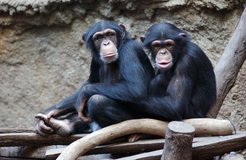Baby’s helping hands
First evidence for altruistic behaviours in human infants and chimpanzees
According to a Yiddish proverb, ‘if you ever need a helping hand, you’ll find one at the end of your arm’. A new study from the Max Planck Institute for Evolutionary Anthropology in Leipzig, Germany offers another place to find one - children and chimpanzees. Researchers developed several helping scenarios in which an adult was struggling with a problem and needed help. In one such scenario, an adult accidentally dropped objects on a floor and was unable to reach them. Human infants at 18 month of age helped spontaneously in several of the tasks. Also, chimpanzees displayed similar helping behaviours, although only in easier tasks. These new findings show that rudimentary forms of altruistic behaviours are present in our closest evolutionary relatives. As recent findings by other researchers from the same institute show, these seem to be restricted to particular situations. (SCIENCE, March 3, 2006).

Felix Warneken and Mike Tomasello found that children as young as 18 months willingly helped complete strangers. ‘The results were astonishing because these children are so young - they still wear diapers and are barely able to use language,’ says Warneken. ‘But they already show helping behaviour.’
Warneken performed various tasks like hanging clothes on a line, and would drop a clothes peg out of his reach. For the first 10 seconds he reached for the peg. In the next 10 seconds he also looked at the child. After 20 seconds he said ‘my peg!’. But he never directly asked the child for help, and did not thank or reward the child if the peg was retrieved. Virtually all children helped at least once in these situations and in 84% of cases they helped during the first 10 seconds, before Warneken even made eye contact.
‘The children didn’t fetch the peg automatically because in another part of the test I threw it on the ground deliberately and they didn’t pick it up. They only gave it to me if they inferred that I needed the peg to complete my goal, in this case, hanging up the clothes.’
In case picking up clothes pegs was something the children had experienced before, Warneken invented new and more complicated situations. One was a box with a flap to retrieve objects inside the box. Warneken accidentally dropped a spoon inside and pretended he didn’t know about the flap. Again, the children only helped Warneken retrieve the spoon if he was struggling to get it, as opposed to when Warneken threw the spoon inside deliberately.
Going to some effort to help someone, without any benefit to yourself, is called altruism. So far, only humans are proven altruists. We donate money to charity, we pay taxes and we help people we don’t know. But never before has this ability been shown in children who are so young who haven’t yet developed much in the way of language skills. The study shows that even infants without much socialization are willing and able to help spontaneously.
But is helping unique to humans? A recent study by Jensen and colleagues [1] shows that chimpanzees only care about themselves when the goal is to retrieve food. However, chimpanzees might help in situations other than foraging. Therefore, Warneken conducted the same helping tasks also with human-raised chimpanzees. Although the chimpanzees didn’t help in the more complex tasks, like the box experiment, they did help when their human caretaker was reaching for something.
‘This is the first experiment showing altruistic helping toward goals in any non human primate,’ says Warneken. ‘It’s been claimed chimpanzees act mainly for their own ends, but in our experiment, there was no reward and they still helped.’
Altruism in chimpanzees may mean our common ancestor already had rudimentary forms of helping behaviour before chimpanzees and humans split six million years ago.
‘People thought helping behaviour was unique to humans, but maybe chimps aren’t as different as we thought,’ says Warneken with a smile. ‘Perhaps there was a tiny bit of altruism in our evolutionary ancestor and it’s grown so much stronger in modern humans.’
